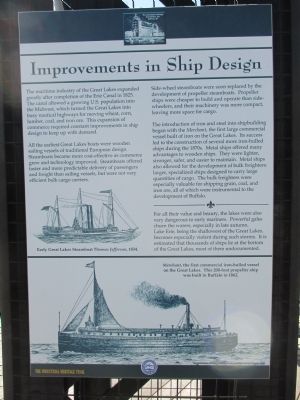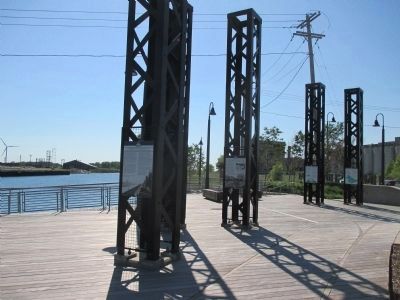South Park in Buffalo in Erie County, New York — The American Northeast (Mid-Atlantic)
Improvements in Ship Design
The Industrial Heritage Trail
All the earliest Great Lakes boats were wooden sailing vessels of traditional European design. Steamboats became more cost-effective as commerce grew and technology improved. Steamboats offered faster and more predictable delivery of passengers and freight than sailing vessels, but were not very efficient bulk cargo carriers.
Early Great Lakes Steamboat Thomas Jefferson, 1834.
Side-wheel steamboats were soon replaced by the development of propeller steamboats. Propeller ships were cheaper to build and easier to operate than side-wheelers, and their machinery was more compact, leaving more space for cargo.
The introduction of iron and steel into shipbuilding began with the Merchant, the first large commercial vessel built of iron on the Great Lakes. Its success led to the construction of several more iron-hulled ships during the 1870s. Metal ships offered many advantages to wooden ships. They were lighter, stronger, safer, and easier to maintain. Metal ships also allowed for the development of bulk freighters: larger specialized ships designed to carry large quantities of cargo. The bulk freighers were especially valuable for shipping grain, coal, and iron ore, all of which were instrumental to the development of Buffalo.
For all their value and beauty, the lakes were also very dangerous to early mariners. Powerful gales churn the waters, especially in late autumn. Lake Erie, being the shallowest of the Great Lakes, becomes especially violent during such storms. It is estimated that thousands of ships lie at the bottom of the Great Lakes, most of them undocumented.
Merchant, the first commercial iron-hulled vessel on the Great Lakes. This 200-foot propeller ship was built in Buffalo in 1862. Image Source: Samuel Ward, American Steam Vessels, 1895.
Erected by The Industrial Heritage Committee, Inc.
Topics and series. This historical marker is listed in this topic list: Waterways & Vessels. In addition, it is included in the Erie Canal series list. A significant historical year for this entry is 1825.
Location. 42° 50.046′ N, 78° 51.288′ W. Marker is in Buffalo, New York, in Erie
County. It is in South Park. Marker is on Fuhrmann Boulevard, ¼ mile south of Ohio Street, on the left when traveling north. Touch for map. Marker is in this post office area: Buffalo NY 14203, United States of America. Touch for directions.
Other nearby markers. At least 8 other markers are within walking distance of this marker. Early Lake Erie Water Craft (here, next to this marker); The Great Lakes (here, next to this marker); Lake Erie (here, next to this marker); The Union Ship Canal (here, next to this marker); The Lehigh Portland Cement Company (here, next to this marker); Bethlehem Steel in Lackawanna (here, next to this marker); a different marker also named Bethlehem Steel in Lackawanna (a few steps from this marker); a different marker also named Bethlehem Steel in Lackawanna (a few steps from this marker). Touch for a list and map of all markers in Buffalo.
Credits. This page was last revised on February 16, 2023. It was originally submitted on July 24, 2015, by Anton Schwarzmueller of Wilson, New York. This page has been viewed 296 times since then and 9 times this year. Photos: 1, 2. submitted on July 24, 2015, by Anton Schwarzmueller of Wilson, New York.

